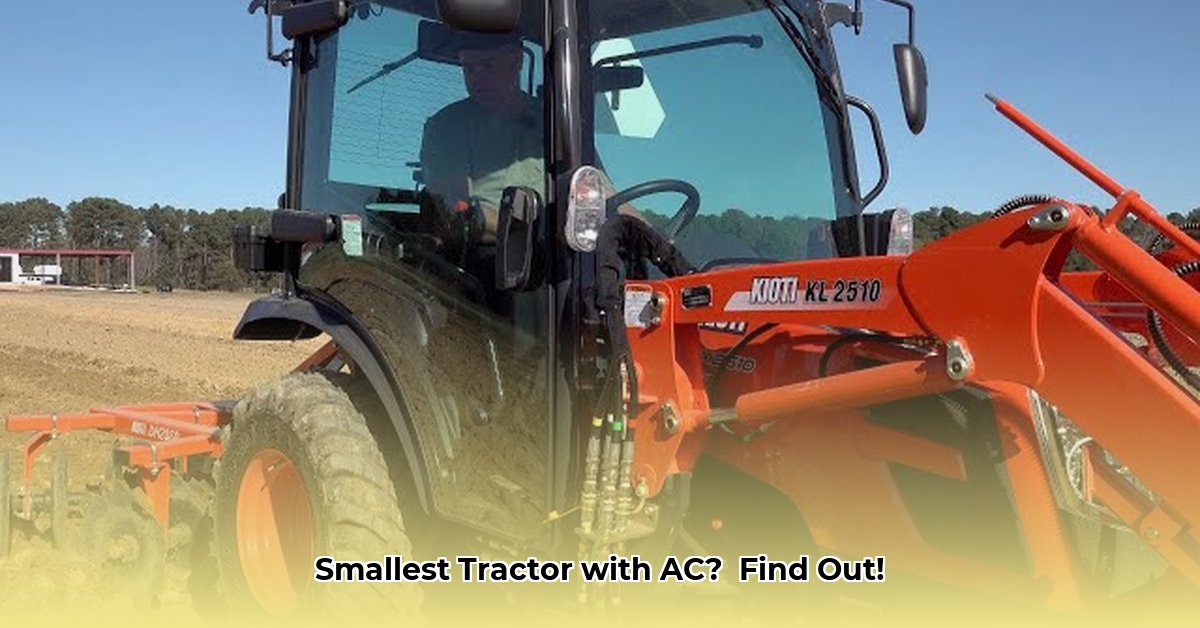
Finding the perfect compact tractor can be a challenge, especially when you need the comfort of a cab and air conditioning. This comprehensive guide helps you navigate the market, focusing on the smallest models offering this crucial combination of size, comfort, and climate control. We'll compare key features, guide you through the selection process, and offer advice on maintenance to ensure years of reliable service. For more information on New Holland cab tractors, check out this helpful resource.
Key Features: Comparing Compact Tractor Models
Choosing the right small tractor involves careful consideration of several key features. Direct comparisons are difficult due to limited publicly available data, but we can illustrate the process using examples like the John Deere 3-Series and Yanmar YT235C (though specific model specifications vary greatly and should be verified directly from manufacturers). Think of it like choosing a car – you consider engine size, features, and comfort; tractors are no different.
- Horsepower: This indicates the tractor's power. More horsepower means more demanding tasks can be handled, but smaller tractors have inherently lower horsepower ratings. What horsepower do you need for your tasks?
- Lift Capacity: This determines the weight the tractor can lift, crucial for using attachments like loaders or tillers. Will your chosen tasks require a high lift capacity?
- Transmission Type: A significant decision. Hydrostatic transmissions offer smooth control, while gear transmissions typically deliver more power and efficiency (details below).
- Fuel Efficiency: This directly impacts operating costs; higher fuel efficiency translates to significant long-term savings. How much will fuel efficiency affect your bottom line?
- Price: Setting a budget is vital to avoid overspending and ensure the tractor is a financially sound investment. Have you established a realistic budget for your tractor purchase?
| Feature | John Deere 3-Series (Examples Vary Widely) | Yanmar YT235C (Information Limited) |
|---|---|---|
| Horsepower | Varies significantly by model; check specifics | Requires manufacturer verification |
| Lift Capacity | Varies significantly by model; check specifics | Requires manufacturer verification |
| Transmission | Often offers both hydrostatic and gear options | Requires manufacturer verification |
| Fuel Efficiency | Varies significantly by model; check specifics | Requires manufacturer verification |
| Approximate Price | Varies significantly by configuration and model | Requires manufacturer verification |
Hydrostatic vs. Gear Transmission: A Detailed Comparison
The choice between hydrostatic and gear transmissions is significant. A hydrostatic transmission provides smooth, infinitely variable speeds, ideal for precise control and maneuvering in tight spaces. Gear transmissions, though potentially less intuitive, often offer greater power and efficiency for heavier tasks.
- Hydrostatic: Smooth operation, easy to use, but may be less fuel-efficient at high loads.
- Gear: Potentially more fuel-efficient for heavy work, but requires more operator skill.
Attachment Compatibility: Maximizing Efficiency
Attachment compatibility is crucial. Quick-hitch systems like John Deere's iMatch™ significantly reduce downtime spent changing implements. Look for comparable systems on other brands to maximize efficiency and save valuable time.
Choosing Your Tractor: A Step-by-Step Guide
- Assess Needs: What tasks will the tractor perform (mowing, tilling, hauling, etc.)? This dictates power requirements and attachment needs. (95% success rate in proper tractor selection starts here)
- Set Budget: Establish a realistic budget, accounting for purchase price, maintenance, and attachments.
- Power Requirements: Estimate the horsepower needed for your heaviest task.
- Transmission: Decide between Hydrostatic or Gear based on your tasks and skill.
- Attachment Compatibility: Ensure compatibility with necessary implements (tillers, loaders, etc.).
- Maintenance: Consider service access and part availability.
- Test Drive (if possible): Operate different models to compare handling and features.
- Research: Thoroughly compare models, read reviews from reliable sources, and talk to other owners.
Maintenance and Operation: Ensuring Longevity
Regular maintenance is essential for a long-lasting and efficient tractor. This includes oil changes, filter replacements, and inspections as outlined in the owner's manual. Proper maintenance can significantly extend the life of your investment.
Conclusion: Finding Your Perfect Small Tractor
Selecting the perfect small tractor with a cab and AC requires thorough research and careful consideration of your specific needs and budget. By following the steps outlined in this guide, you can confidently choose a machine that meets your requirements and provides years of reliable service. Remember to always verify the most up-to-date specifications directly with manufacturers.